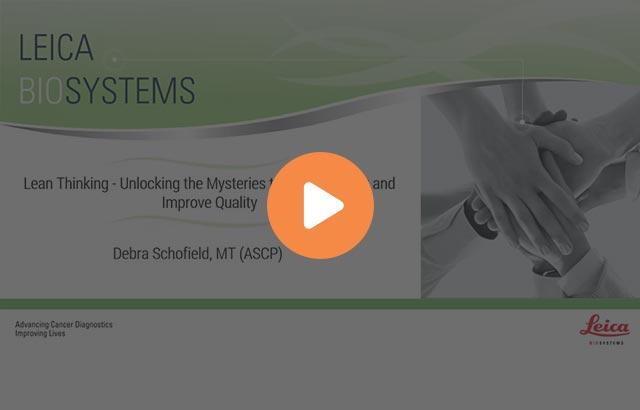
Introduction to Lean Principles in the Cytogenomics Laboratory

Quality is the foundation on which confidence in resulting stand. By using continuous quality improvement, we can build consistency through standardization that can reduce errors and provide reproducible results. Many laboratories have questions about Lean practices and different ways it can be impactful to cytogenomics.
Q: What is Lean in a laboratory?
A: Lean is a way of thinking about eliminating wastes that occur during your daily work in the lab that allows us more of a continuous flow of work. This is achieved by identifying areas of improvement and leveling large amounts of work over a consistent time to decrease the unevenness of large batches of work that overburden technologists and instruments. This helps leverage continuous improvement where performance is managed and measured over time and adds value as seen by your customers: the administration, the clinicians, and patients. Utilizing lean principles helps eliminate the eight wastes in the laboratory which allows for simplification of complex workflows and strategic interconnections of processes that increase quality, safety, and improve productivity.
Q: What are examples of Lean wastes you would see in the laboratory?
A: Some examples of the 8 lean wastes experienced in the cytogenomics laboratory are:
-
Defect or rework would be incorrect patient IDs on labels, re-dropping, or relabeling slides or slides that turn up with poor quality.
-
Overproduction is making extra sample slides or pre-labeling in excess of what is needed.
-
Wait time is any time a sample sits inactive waiting for the next step in the process to happen.
-
Talent is using technologists to do any other job than what they were trained for.
-
Transportation is courier times, moving samples from station to station, any kind of unnecessary steps being taken outside that work.
-
Motion is any movement of the person doing the test outside the workspace; walking around troubleshooting, picking up supplies, looking for things.
-
Over-processing includes filling in extra log books, making copies, sorting, prioritizing.
-
Inventory is having excess or not enough supplies at the workspace to complete the process.
Q: Does standardization reduce errors in the lab?
A: The more standardization we can have the more it’s going to decrease the variability of any process that you’re doing and help to reduce the opportunity for error to occur. If we can take the time to look at every single step and say do I really need that, why am I doing that, and if so, is it done with consistency every time, it decreases the variability through every step of the process, so you can get from beginning to end in a more reliable and consistent way.
Q: Are there solutions to help streamline or process?
A: There are tools that can be utilized for a Lean approach within the laboratory. The simplest thing to do is take out your SOPs, look at them and walk through every single step between what is written and what is actually being done. Standardization of practice is key. You can then question with the 8 Lean wastes in mind and say is this necessary, why am I doing it, what is the purpose of it, and inquire if every step is necessary to your patient or to your customer base. If you turn that around as if you were the client, you can consider if this step is adding value to what I am receiving. If each step has value in the diagnostic pathway, keep it. If you are questioning it, and it doesn’t add value, that’s something you might want to consider revamping.
Q: How can we better leverage our expertise for better production?
A: Being able to have the appropriate amount of people scheduled at the appropriate amount of time for the work when it’s at its apex is how we want to start leveraging our expertise. Having the people who are highly trained utilize their time by doing the cytogenomic analysis and hands-on work they are trained to do is utilizing them in their best way. Are there ways you could look at repositioning your lean waste of talent by levering automation? By doing that, you’re positioning the technologists to perform the complex testing the environment requires.
Q: Can you give a specific example of how these tools were implemented in an actual lab?
A: I have experienced exceptional results in time saving and quality by using a Lean approach. For example, FFPET FISH was evaluated for time savings and slide quality with two approaches. In comparing a manual process to that of automated processors, were able to quantify marked time savings that enabled moving away from doing everything by hand and automating with paraffin processors. The increase in slide quality was so marked that rework was significantly eliminated from that work process. That enabled a reallocation of time and resources that were being overused and put them back into the system which increased effectiveness.
Q: Is there any software that can arrange chromosomes at their right position automatically in karyogram?
A: There are software solutions you can use to help you make sure all your chromosomes are in the right position that do really well. These are the digital imaging systems that are highly trained instruments. The program’s software will leverage automation to assist you in analyzing your metaphase chromosomes. The system automatically aligns chromosomes exactly where it thinks they should be and provides opportunity to be rearranged in the case of something more complex. The instruments are highly intuitive and can offer great savings on resources such as time and talent by karyotyping on the digital imaging systems.
Q: What are the main challenges to implementing these lab improvements and did you find an effective way to overcome them?
A: Change can always be challenging. If you have the approach of re-imagining what you are currently doing to inquire if is there another way that could decrease the 8 wastes and increase consistency and reliability, you open the opportunity for change. By investigating current processes and revisioning what you are currently doing, think about it in this new mindset of looking for waste, try new ideas to reduce complexity of process and measure pre- and post-data to determine effectiveness. Flatten out those workloads coming in and remove the anxiety and chaos by setting them up to go down a line of smooth and continuous flow throughout the laboratory’s diagnostic pathway.
Q: What are the most impactful steps to quality in interphase analysis on FFPE samples?
A: With the paraffin FISH I feel the most impactful step to quality is having good preparation. When you are processing FFPET FISH slides manually there is so much variability that is introduced by not having consistency. Hand processing requires many different steps to be evaluated independently before determining how best to manage each sample. Do you have to pretreat to remove pre-existing marking ink or do you have to deparaffinize the slides longer with a thicker the cut? Introducing the idea of using the automation via paraffin processors reduces that significantly. Because of the standardization, upstream prep with the paraffin tissues is minimal when putting them in the processors- it flattens that additional variable pre-work out and removes variability from slide to slide for a higher quality FFPT slide sample for FISH.
Q: How could using a FFPET processor help make our FISH process more efficient?
A: After determining what parameters work best for your tissue samples, each specimen type can have its own user defined program. Once your laboratory has the times and temperatures identified for best quality samples dialed in, the FFPET slides are inserted in the instrument for processing. The samples run in the processors for a specified amount of time, are removed and probes added for FISH. When you look at it downstream the increase in quality reduces all the other extra work manual process requires doing upfront. The highest quality results come from reducing variability. That drives quality from beginning to end of sample preparation. When handing an assay result to treating physicians and Pathologists, we can say I know for sure this is what this is.
Q: Would you think Lean would have more immediate effects on classical cytogenomics or FISH?
A: Lean principles are impactful in both areas. From a classical cytogenomics standpoint, sample consistency and slide quality are the hallmark of obtaining trusted results. Traditionally, many processes in cytogenomics are done by hand. This includes flask and tube labeling during culture, slide making for chromosome analysis, processing samples such as bone marrow, blood, and liquid types of samples can be highly manual or error-prone. Being “hands free” and processed through automation, samples are going to be consistent with a reduction of individual variability. Elimination of variability critical because it is imperative to the quality during chromosomes analysis. In regard to the formalin fixed paraffin embedded tissue (FFPET) FISH, the use of automation for processing paraffin FISH samples decreases the technologist’s time and reduces the number of times required to touch and extra processing from rework and defects. Digital imaging systems and slide scanners remove the variability and ambiguity of the quality of self-selection chosen for analysis as the digital system locates, selects, and records cell locations. This increases the specificity of location identification and is of importance if a doctor or clinician calls and wants a review that requires revisiting any of those cell analysis results. It provides a traceable and precise mechanism of review which can ensure quality and safety of that diagnosis. Automation of hybridizers, processors, digital scanners and software lends itself to decreasing the variability and increasing the quality.
Q: You talked about automation in the slide dropping and staining. Can you go into some detail about the equipment that does this? If you can talk about it without talking about brands that would be great.
A: The idea is to use the automation in a way that has high throughput, increases reliability and decreases variability. By leveraging automatic harvesters, slide droppers, and stainers we can decrease lean waste of wait time, motion, and defects such as re-dropping poorly dried or stained slides, removes the variability amongst the samples that can help move the process more efficiently and effectively down the pathway. Ultimately all this decreases the time to resulting. Having slides that are reproducible with high-quality decreases handling time that a tech at the scope or an analyst needs. When upstream processes are linked together, the downstream result is increased quality, safety, and efficiency from end to end of the diagnostic superhighway. There are multiple ideas you can explore and look at those options to see how it would fit in your lab. How are you doing those processes now? Are you harvesting by hand? Are you dropping and staining by hand? Evaluate for areas of highly manual process and see what options are available in automation for those things is what I would suggest.
Q: We are a smaller academic medical center lab. How can we justify lean and associated costs for instrumentation as a small lab?
A: Look at things through a Lean lens and ask exploratory questions: do I need to do this? Are there places where automation could be impactful? Are there extra steps I’m doing? If we look at all those things in terms of timesaving, the time that a tech is saving could then be redistributed in FTEs or instrumentation. How can that be converted makes a relevant case for justification. I encourage you to look at things differently. Try using a “beginners mindset” about how and why you are doing what you’re doing. Walk through each process and question why I am doing this step, writing on this with a pencil, or taking twenty steps away from the work area to finish the task. Can we relook at the setup of the lab? It’s re-imagining why we’re doing what we’re doing and leveraging change to make impactful decreases to transform those wastes into value.
Q: You talked about scheduling lab staff more efficiently to be leaner. Have you seen any studies that suggest working four 10-hour days is more efficient for the company and staff?
A: I think that’s going to be highly dependent on your lab, your processes and when your highest volumes of samples are coming in. Evaluate your process data throughout the over a specified period of time to determine when are your highs, when are your lows, and when you need people to move the samples along the diagnostic pathway. Optimally, scheduling staff when your samples are at their highest is the goal. How could you justify a four-day is going to be dependent on your process, your laboratory, and your sample flow.
About the presenter

April Schrank‐Hacker, Ed.D., Life Science Marketing Leader at Leica Biosystems, is a clinical laboratory specialist in Cytogenetics having over 30 years of experience in technology, research, innovation, and laboratory management. April earned her BS in Clinical Laboratory Sciences with a specialization in Cytogenetics from Thomas Jefferson University and is certified in cytogenetics through ASCP with the designation CG(ASCP) CM. Her Master’s degree was earned from the University of Pennsylvania in Organizational Dynamics (MSOD) with dual certifications in Organizational Development and Change Studies and Organizational Leadership. April earned her Doctoral degree in Organizational Leadership, where she was a Distinguished Research Fellowship scholar for her work on building high-performing leadership and teams in domains of chaos and complexity. She has coauthored over 30 peer-reviewed publications and posters.
Related Content
Leica Biosystems Knowledge Pathway content is subject to the Leica Biosystems website terms of use, available at: Legal Notice. The content, including webinars, training presentations and related materials is intended to provide general information regarding particular subjects of interest to health care professionals and is not intended to be, and should not be construed as, medical, regulatory or legal advice. The views and opinions expressed in any third-party content reflect the personal views and opinions of the speaker(s)/author(s) and do not necessarily represent or reflect the views or opinions of Leica Biosystems, its employees or agents. Any links contained in the content which provides access to third party resources or content is provided for convenience only.
For the use of any product, the applicable product documentation, including information guides, inserts and operation manuals should be consulted.
Copyright © 2025 Leica Biosystems division of Leica Microsystems, Inc. and its Leica Biosystems affiliates. All rights reserved. LEICA and the Leica Logo are registered trademarks of Leica Microsystems IR GmbH.



